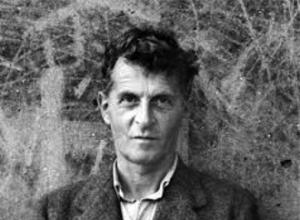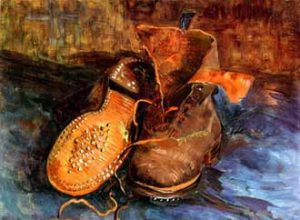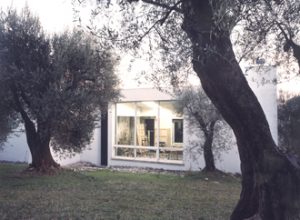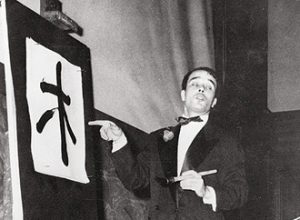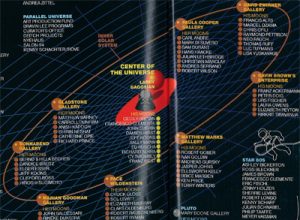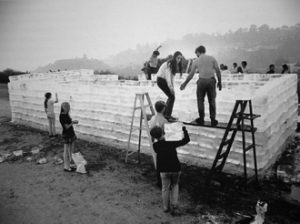
A look at the major figure of Allan Kaprow takes us back to that moment during the 1950s and 1960s when the discourse of modern formalism began to break up and to leave some room for less established positions. With an ever increasing chance of being understood, the time had finally come to lay down a radical critique of the conditions of the arts scene and to attempt a shake-up of everyday life, a reconciliation of art and life, and a break with the warped position of a spectator who remained simply passive.
A representative of what would become Fluxus and in the wake of John Cage at the New School for Social Research (where he spent time between 1956 and 1958), Kaprow defended a form of “happening” that, as early as 1959 and his Eighteen Happenings in Six Parts, advocated making the demarcation between art and life as fluid and indistinct as possible.
The idea of merging art and life in a spirit of permanent rebirth took root in the United States in the nineteenth century and was to be found in the writings of Ralph Waldo Emerson, Henry David Thoreau, and Walt Whitman–even though, after them, the contemporary situation was to pass by way of forms of desacralization these pioneers would themselves no doubt not have accepted. Between that time and the 1950s, the pragmatist philosopher John Dewey took up the torch and demanded from artists a sense of continuity between art works, events, and the little things of everyday life that ground “experience.”
Sophie Delpeux and Gilles Tiberghien see in Art as Experience–Dewey’s most important work, published in the 1930s–a “manual” that Kaprow would have used for himself. In this way, they assess the extent of the dialogue that was established between the artist and the philosopher, beyond changes in the historical context.
In doing so, these authors raise the question that ceaselessly comes back to us, that of knowing what purpose a text–a philosophical text–may serve for an artist.
Laurence Bertrand Dorléac
Seminar of June 11, 2007
Art as Experience
Sophie Delpeux and Gilles Tiberghien
It happens, more often than one thinks, that artists read philosophers. Among contemporary philosopher-inspired artists are Joseph Kosuth, Hermann de Vries, Robert Morris, Bill Viola, Daniel Buren, and Fabrice Hyber. And among their references are various spiritual masters, theorists of all kinds, Maurice Merleau–Ponty, Ludwig Wittgenstein, Martin Heidegger, Jacques Derrida, Gilles Deleuze, Meister Eckhardt, Ananda K. Coomaraswany, and the writings of Zen masters. The December 2003 issue of Anne Moeglin-Delcroix’s La Revue d’Esthétique (no. 44), which bears the title “Les artistes contemporains et la philosophie” (Contemporary artists and philosophy), corroborates such affinities. In her article, “Expérience et performance. Fragments d’un discours pragmatiste” (Experience and performance: Fragments of a pragmatist discourse), Yoann Barbereau delineated the theoretical contours of the dialogue that took place between Allan Kaprow and John Dewey, correctly noting that “the years during which one saw analytical aesthetics begin to dominate debates in philosophy were also those in which an act was performed on the artistic stage; at its center was found what the theater of philosophical operations had driven off stage, [Dewey’s] Art as Experience.”[ref]Yoann Barbereau, “Expérience et performance. Fragments d’un dialogue pragmatiste,” La Revue d’Esthétique, 44 (December 2003): 25.[/ref] This preliminary theoretical point now having been established, our idea was to take a somewhat closer look at this dialogue, but in a less transversal context, and to pinpoint how it influenced Kaprow’s very practice.

Allan Kaprow, Fluids, octobre 1967, photo Dennis Hopper.
An Ethic of Creation
A reading of Kaprow’s theoretical texts as well as a study of documents relating to his happenings, activities, and events reveal how strong an impression the reading of Art as Experience had left on him. In a certain way, that book was able to constitute, for this artist, a veritable “manual.” Criticism of museums, of institutional settings, and of commercial values–all factors serving to hamper the viewer’s involvement and thereby to obstruct the viewer’s experience, according to Dewey–indeed, this whole distancing of art from its public, upon which Dewey had reflected at the outset of this essay, was also for Kaprow a recurrent theme, one that he was going to radicalize in the course of his career.
In the first chapter of his essay, Dewey pointed out a caesura. Museums are, according to him, at once the cause and consequence of the distance modern society has established and maintained between people and art–a distance that, again according to him, is scarcely desirable if works are to be the source of a genuine experience. The author expresses his regret that art would thus be “remitted to a separate realm” and removed “from common or community life.” [ref]John Dewey, Art as Experience (New York: Minton, Balch & Company, 1934; New York: Perigee, 1980), pp. 3, 6.[/ref]».
Consequently, it is incumbent upon the “philosopher” who undertakes to write about the fine arts to counter this dominant tendency while restoring “continuity between the refined and intensified forms of experience that are works of art and everyday events, doings, and sufferings that are universally recognized to constitute experience.”[ref]Ibid., p. 3.[/ref] Thus, in order to understand the aesthetic “in its ultimate and approved forms,” it is fitting to begin to seek it “in the raw.” What is the aesthetic? Dewey answers as follows: “the sights that hold the crowd–the fire engine rushing by; the machines excavating enormous holes in the earth; the human-fly climbing the steeple-side; the men perched high in air on girders, throwing and catching red-hot bolts.”[ref]Ibid., pp. 4-5.[/ref]
Such an enumeration testifies to an involvement in the modern world, its noises and its construction efforts, that is in keeping with the one Kaprow wrote down in “The Legacy of Jackson Pollock,” his 1958 manifesto: “we must become preoccupied with and even dazzled by the space and objects of our everyday life, either our bodies, clothes, rooms, or, if need be, the vastness of Forty-second Street.”[ref]Allan Kaprow, “The Legacy of Jackson Pollock,” Essays on the Blurring of Art and Life, ed. Jeff Kelley (Berkeley, CA: University of California Press, 2003), p. 7.[/ref]. Kaprow decided that from then on he would “show us, as if for the first time, the world we have always had about us but ignored.”[ref]Ibid., p. 9.[/ref] –which was, according to Dewey, one of the conditions for experience.
This shared idea of a rediscovery of the everyday nevertheless had, for Dewey, a different purpose. Breaking up routine and experiencing modern life fully allow him to think aesthetic experience as one specialized form of that experience, whereas what Kaprow, for his part, proposed was to make a reinvestment in the everyday his sole goal. Pollock, as Kaprow put it, had killed art by transforming it into a world to be traveled through, and aesthetic experience was thereby to be dissolved into simple, straightforward experience.
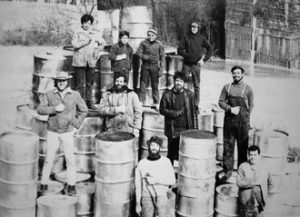
Allan Kaprow, Transfer, 1968, photo Andy Glantz
Definitions of Experience
Dewey distinguishes between experience and “an experience.” One experiences all sorts of things in a superficial, incomplete, and vague sort of way, whereas one has “an experience” when one follows through on it fully. In this way, one can sift out the main features that, in Dewey’s view, make up an experience.
Experience forms a whole, and the parts of this whole are connected. In “an experience,” there is a movement from one point to another. Next, an experience is specific; it has a unity that is its “proper designation.”[ref]Art as Experience, p. 40.[/ref] This character of its own gives it what could be called a style and ensures that every genuine–that is to say, consummated–experience is aesthetic. This is true of a conversation, of a successful dinner, or of a thought experiment, to take a few examples. Finally, an experience always presupposes something foreign entering in, something that does not occur without difficulty since “there are few intense esthetic experiences that are wholly gleeful.”[ref]Ibid., p. 41.[/ref]
For Dewey, however, his model for experience is organicist. Indeed, all experiences, however varied they may be, are for him “the result of interaction between a live creature and some aspect of the world in which he lives.”[ref]Ibid., pp. 43-44.[/ref] This idea would strike Kaprow as natural, since for the latter the notion of environment is central–except that, from Dewey’s perspective, it is hardly possible to separate the aesthetic from the artistic, insofar as reception and production are always tied together and insofar as a viewer is always also, no matter how small the extent, an actor. And happenings, insofar as they do indeed demand the public’s participation, are fully artistic experiences–though, in Dewey’s vocabulary, that would be almost a tautology.
Involvement and Sharing
This is in fact a significant phenomenon. What Kaprow does in practice is radicalize Dewey’s argument while remaining very faithful to him. To gauge how scrupulously the former respects the latter, let us mention two other brief examples, both of them also coming from this first chapter of Dewey’s essay. As before, here again Kaprow seizes on Deweyan themes so as to push them to their most radical conclusions.
In addition to criticizing museums, Dewey had condemned an art market that establishes works in terms of value, thus depriving them of their full force. Such works can no longer be experienced by the public because they have been replaced by a simple-minded procedure of recognition or attribution. In this context, art objects “serve as insignia of taste and certificates of special culture.”[ref]Ibid., p. 9.[/ref] Taking this situation no doubt very seriously, Kaprow himself hardly produced any objects at all that might be speculated upon or that would last over time. He endeavored throughout his career to offer real-time experiences to people actually present, ones who would no longer be spectators but, rather, participants. Indeed, this notion of presence and involvement is mentioned as early as the first chapter of Art as Experience, too.
Dewey lays a lot of emphasis on the importance of community. He begins by specifying, “I do not say that communication to others is the intent of an artist. But it is the consequence of his work. . . . In the end, works of art are the only media of complete and unhindered communication between man and man that can occur in a world full of gulfs and walls that limit community of experience.”[ref]Ibid., pp. 104-105.[/ref] Whence the importance of friendship, often cited as an example in his book so as to contrast it with mere skill and in order to illustrate what another culture entering into our own can be like. This was an idea that could not have escaped Kaprow’s attention, for his entire life and work testify to a will to set in motion, in art as in society, one and the same collective impulse. In Dewey’s footsteps, Kaprow also took a keen interest in pedagogy.
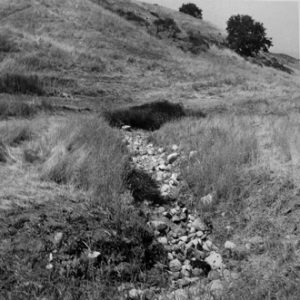
Allan Kaprow, Easy, 1972, photo Bee Ottinger
Art and Philosophy
These are so many features that allow us to gauge the extent to which Dewey’s text had influenced Kaprow and to see how he tends, with those secular rituals of his that are happenings and then “activities,” to put it into practice. They are also so many celebrations of the contemporary world and of the degree to which man can enter into it. Clearly, Dewey mentions rituals in the first chapter of his essay for their characteristic of being a full-fledged component of community life–gestures and objects–but it is quite obvious that at no moment does he envision the possibility of their reappearance as Kaprow was going conceive it. In this context, art is not the continuation of philosophy by other means. Nor is art its “relief” against–in some Hegelian sort of way, as if philosophy found its fulfillment through art and no longer the other way around. For artists, philosophy is often a sort of “precipitate” in the chemical sense, an elementary formula that allows them to test a set of propositions that sometimes seem very far removed from the thought inspiring the but that in fact are only its sometimes unrecognizable products, of which they nevertheless constitute the real core. Between Dewey and Kaprow, the connections are much more obvious in appearance, but no doubt one must seek deeper within the conceptual tissue of Dewey’s thought in order to rediscover in Kaprow the basic elements that stimulated his practice throughout his life. Yet one thing is already certain. Philosophy and art, as Kaprow speaks of them, have this in common, that they allow him to escape so thoroughly from formalities and self-reflection that one could say, in paraphrasing Robert Filliou, that for Kaprow philosophy is also what makes life more interesting than philosophy.
P.S.: During our June 11, 2007 joint lecture, we described and discussed three of Kaprow’s happenings and activities: Fluids (1967), Transfer (1968), and Easy (1972). During the first two of these, groups of volunteers were asked to carry out various building and storage tasks in the company of Kaprow. Often futile–building a structure in ice under a blazing sun, moving empty barrels from their storage site and back to the same place in several stages–such undertakings nevertheless mobilized all the participants’ energy and their attention. These two happenings had no other purpose than to highlight shared life experiences and instances of mutual aid–in short, a certain poetry of the moment and of the everyday that nothing of a purely material nature could capture.
Easy, from 1972, marks the transition to “activities”–which are more discreet, more introspectively oriented. Here, Kaprow invited a group of students to pick up stones two separate times from a dry river bed, wetting them. This served as the occasion for each person to put something of himself on and in inanimate objects and to gauge the uniqueness of the first experience by comparing it to the second, more predictable one.
Bibliography
Allan Kaprow. Milan: Skira, 1998.
Barbereau, Yoann. “Expérience et performance. Fragments d’un dialogue pragmatiste,” Revue d’Esthétique, 44 (December 2003): 24-35.
Buchloch, Benjamin H. D., and Judith F. Rodenbeck. Experiments in the Everyday: Allan Kaprow and Robert Watts, Events, Objects, Documents. New York: Columbia University, 1999.
Cometti, Jean-Pierre. L’Amérique comme expérience. Pau: Publications de l’Université de Pau, 1999.
Delpeux, Sophie. “‘Partir des arts.’ La modernisation du métier d’artiste selon Allan Kaprow.” Les écrits d’artistes depuis 1940. Saint-Germain-La-Blanche-Herbe: Imec, 2004: 444-54.
Dewey, John. Art as Experience. New York: Minton, Balch & Company, 1934.
Kaprow, Allan. Assemblage, Environments & Happenings. New York, Abrams, 1966.
Kaprow, Allan. Essays on the Blurring of Art and Life. Ed. Jeff Kelley. Berkeley: University of California Press, 2003.
Kelley, Jeff. Childsplay. The Art of Allan Kaprow. Berkeley: University of California Press, 2004.
Schusterman, Richard. Pragmatist Aesthetics: Living Beauty, Rethinking Art. 2nd ed. Lanham, MD: Rowman & Littlefield, 2000.
Sophie Delpeux who has a doctorate in art history from the University of Paris I, is now an associate professor there. Her academic work bears on Happenings, Performance Art, and Body Art from the late 1950s to the mid-1970s and on how a memory of these art forms is constructed. She is presently concentrating her research on Allan Kaprow. Her latest published article is entitled “Paternités de Dennis Oppenheim,” Les Cahiers du Musée d’Art Moderne, 99 (Spring 2007).
Gilles Tiberghien is an associate professor at the University of Paris I, where he teaches Aesthetics. A member of the editorial committees of Cahiers du Musée d’Art Moderne and Carnets du Paysage, he has published, among other books, Land art (Paris: Éditions Carré, 1993), Nature, art, paysage (Arles: Actes-Sud, 2001), Amitier (Paris: Desclée de Brouwer, 2002), and Notes sur la Nature, la cabane et quelques autres choses (Paris: Le Félin, 2005).
